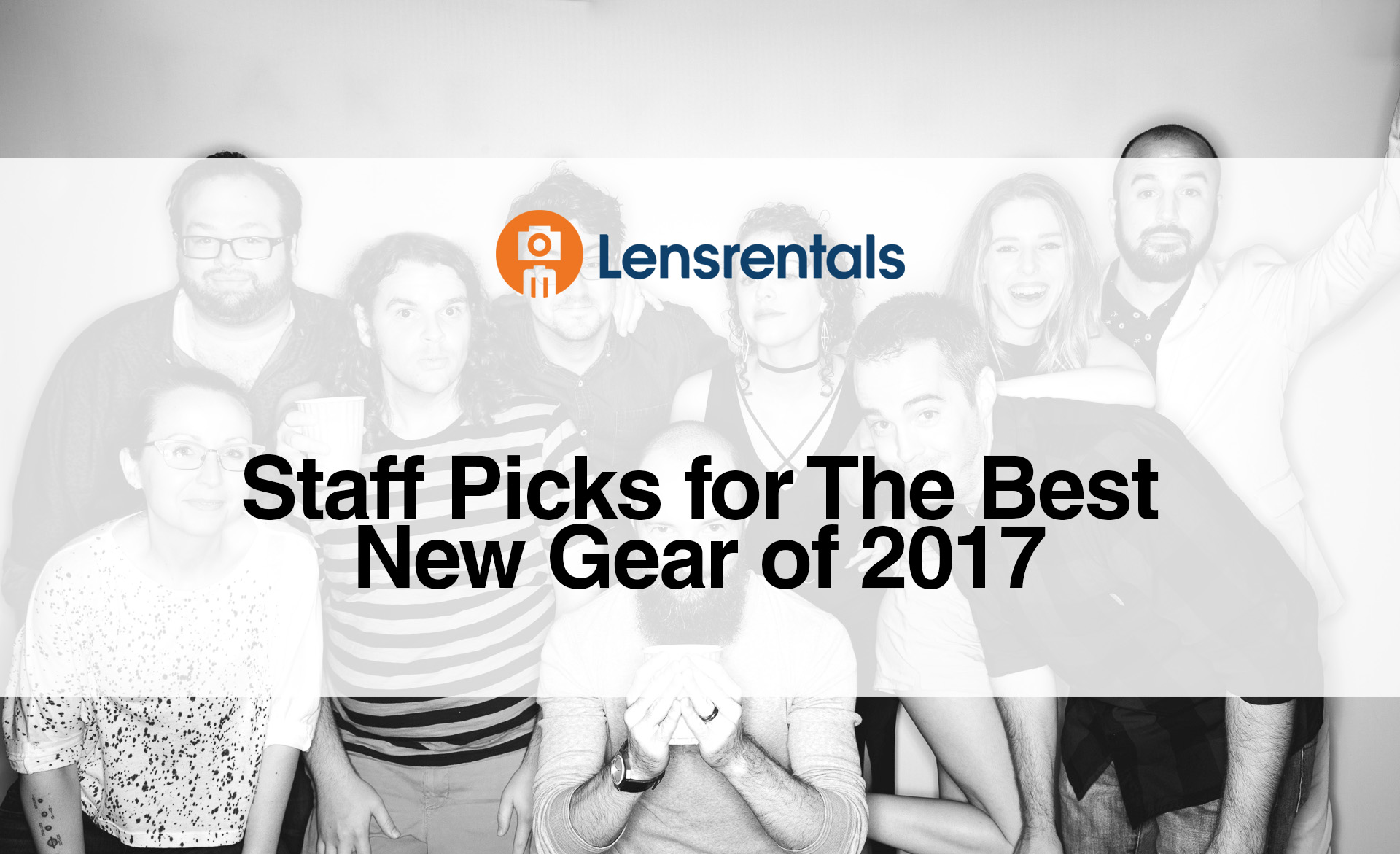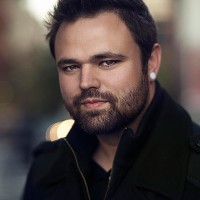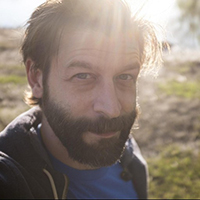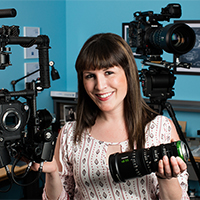Equipment
Staff Picks for The Best New Photography and Videography Gear of 2017

Last week, we shared with you our most popular photo and video rentals for 2017. While that list is extremely telling to market trends and what the average consumer looks for when it comes to gear and tech, but it doesn’t necessarily mean it’s our favorite gear personally. With being the largest photo and video rental house in America, much of our staff have the unique opportunity to handle hundreds of different pieces of gear every day. With continually handling, cleaning, inspecting, and using this gear, we’ve come across many of our favorites for the year. So we went around the office and asked some of our lens techs, our repair techs, and our video techs what their favorite pieces of new gear were for 2017.
Please note, this list includes our favorite gear that was released and announced in 2017. Many of us are still using and are extremely happy with products released in previous years, so we’ve limited this list to just the stuff from the past calendar year.
Staff Picks
 Joey Miller Joey Miller |
Leica M10Leica has finally made the perfect rangefinder. I’m not gonna say it’s the perfect camera because rangefinders aren’t for everyone, but everything about it is exactly what I need in a camera. The minimal interface gets completely out of the way and just lets me make images. It’s not the best sensor out there, it’s not the most advanced in any particular area, but everything it does is done extremely well. Fujifilm GFX 50SIn the battle of the mirrorless medium format cameras, this one takes the cake for me. Sure, the Hasselblad X1D is smaller, lighter, and maybe a little sexier, but the Fuji GFX 50S is just a better overall experience. Quick to focus, an expanding selection of great lenses, all major functions right at your fingertips, optional 90° viewfinder, and damn fine image quality. Medium format on a budget has never been so good. |
 Roger Cicala Roger Cicala |
Nikon D850The Nikon D850 was huge in several ways, not the least of which was that it steps away from “you need a sports camera and a high-resolution camera” so strongly. At 45-megapixels with still-excellent dynamic range and low noise even at high ISO, the images are superb. The autofocus is as good as the best sports camera – 9 frames per second is fast enough for nearly everyone – and the time-lapse and stacking features are awesome. |
 Nick Hall Nick Hall |
Sigma 85mm f/1.4 Art SeriesMy favorite lens of 2017 was hands down the Sigma 85mm f/1.4 Art. There’s not really a lot to it other than it simply being a great lens at an incredible price. You can get down to specifics if you want, but overall it’s just as good as the Canon and Nikon 85s for nearly half the price. Need I say more? Tamron 70-200mm f/2.8 SP Di VC USD G2The Tamron 70-200mm f/2.8 SP Di VC USD G2 is another one of my favorite lenses released in 2017. I like to root for the underdog, so I’m always praising Tamron and Sigma, especially when helping our customers choose between paying for name brand and third party. Tamron has upped its game in the last couple years and I think this new 70-200 might be their best. Its autofocus is always on point and the images you get are ultra crispy. My favorite thing about this lens is its stabilizer, which might be the best I’ve ever seen in a lens. I shot for a local high school football team this year and used this lens a lot. I was able to keep a 400mm prime on my tripod and when the players got close enough to the end zone I was behind, I could take the camera body off of the 400mm and use the Tamron 70-200 handheld without it being wobbly at all. |
 Ryan Hill Ryan Hill |
Canon C200The Canon C200 is REALLY CLOSE to being my ideal documentary camera. All I want in this world is something that combines the image quality of the Canon C300 Mark II with the form factor of the Sony FS5, and the Canon C200 is as close as I got in 2017. Sure, I’m a little annoyed by the lack of a mid-range codec between RAW and low-bitrate MP4 files, and the ergonomics could be improved a little. It’s still giving me the same sensor as the C300 Mark II in a size more suitable to a single operator, though, and that’s enough to make it one of my favorite new cameras of 2017. The RAW files grade beautifully, and Canon’s dual pixel autofocus remains one of the most genuinely useful features available from any manufacturer, especially when paired with the Canon C200’s touchscreen monitor. Canon also tends to make carefully-considered improvements from product cycle to product cycle (see the LEMO connections and swappable monitor cables on the C300 Mark II), so consider me very optimistic about the future C200 Mark II. Panasonic GH5While I don’t personally shoot a lot with SLR-style cameras like the Panasonic GH5, I’m still blown away by the feature set and image quality Panasonic managed to pull off in a camera this size at this price point. Internal 10-bit 4:2:2 4K to SD cards is pretty unbelievable on its own. Add to that professional vectorscope and waveform monitoring, V-log with LUT support, 5-axis sensor-based image stabilization, and a full-size HDMI port, and you’ve got by far the most capable camera we carry at this cost. Of all the new products we get in every year, the ones that impress me most are those that feel sort of experimental. I like to see manufacturers push the limits of their technology and really try something new rather than just churn out iterative updates. I think that’s where Panasonic is now, taking bolder risks than Canon or Sony in an effort to carve out a little of their market share, and I’m excited to see where that approach takes them in the future. |
 Sarah McAlexander Sarah McAlexander |
Canon 85mm f/1.4L ISBecause I normally reach for the Canon 85mm f/1.2 when I shoot portraits, I couldn’t wait to try the new Canon EF 85mm f/1.4L IS USM. I was blown away by the fast autofocus and incredible sharpness, but whats most impressive is that it has the widest ever aperture in an image stabilized lens. This makes shooting handheld in low light so much easier. I rarely shoot wide open so I am happily trading a bit of depth for this quicker and lighter portrait lens. |
 Zach Sutton Zach Sutton |
Sony a7R IIII should preface this with the reality that I haven’t even used the Sony a7RIII. With its recent release, we haven’t had enough copies in stock for me to get a weekend rental with it just yet. But even still, I can’t contain my excitement. Admittingly, I care very little about innovations in the camera field and focus more on lighting and lens advancements. However, it wasn’t until the Sony a7RII that I really started getting interested in technology that can exist in a camera. In short, the Sony a7RII has been the only camera to ever sway me away from my love for Canon, and the Sony a7RIII improves on that system in nearly every way. So while I haven’t used the camera yet, my biased love for what Sony is doing, has already convinced me that when I finally get my hands on the Sony a7RIII, it’ll be my favorite camera of 2017. Sigma 135mm f/1.8 Art SeriesIf you read my review of the Sigma 135mm f/1.8 Art Series, you’ll know my love affair with the focal length and all that this lens can do. In short, the Sigma 135mm f/1.8 Art series is every bit as good as anything else that the Art Series badge has been renowned for, and it does it at f/1.8 while the Canon and Nikon counterparts are still stuck at f/2. While big and bulky, the Sigma 135mm f/1.8 Art is a pretty incredible lens and really outshines the competition. |
 Erik Morrison Erik Morrison |
Sigma Cine LensesWhen I started at Lensrentals, the video world had just gone through a sea change due to the release of the 5DmkII. The landscape was suddenly new, and strange; so filmmakers sought safe harbor with the familiar Zeiss brand. We recommended a lot of Zeiss lenses at that time, and very rarely had conversations about Sigma lenses that didn’t start with qualifiers like, “budget”, “value”, and “good enough”. These days the conversations are a lot different. Sigma has established themselves as a premier brand with a sharp focus on optical quality. The new Sigma cinema lenses quickly established themselves as a peer to their Zeiss analogs, as sharp, well built, production-friendly lenses. These days, absent any qualifiers, I recommend a lot of Sigma cine lenses. Olympus ED Pro 25mm & 45mm LensesI primarily shoot with Olympus micro 4/3 cameras. It’s my opinion, that despite having a smaller sensor, these cameras can produce comparable results, and offer similar features to those of full frame professional cameras. Their exceptional line of f1.8 primes would be considered pancakes on larger sensor systems, and that’s how I like it. The lighter and easier it is for me carry around a camera, the more likely I’m going to have one on hand, especially, in this age where we always have a camera on our person. So, it was with a little bit of apprehension that I first took home the relatively huge, f1.2 ED Pro lenses from Olympus. These lenses are great! With them, you get the trifecta of fast, sharp, and a responsive AF. Again, these lenses are more than comparable to their full frame contemporaries, and their advantages, when I need the extra firepower, more than make up for the extra heft in my camera bag. |
 Kris Steward Kris Steward |
Zeiss CP.3 LensesSize matters, don’t let anyone tell you otherwise, but are bigger cinema lenses really better? The large ones certainly look impressive, they have a satisfying heft, and that’s probably why they’re so popular with customers. That said, in our experience, big cinema lenses can be awkward to work with and cause a lot of discomfort. That’s why we are so happy with Zeiss’ CP.3 lenses, they reduced the size of a cinema lens without compromising the quality. We still get a lot of requests for those fat, girthy ones, the customers practically beg us for them; however, once you try these new Zeiss lenses, you’ll never go back. The CP.3s have become a new favorite in our office. We like small ones around here. Sony FS7 Mark IISony’s FS7 Mark II was definitely my favorite camera this year. We were thrilled by the locking lens mount, improved EVF mount, and that terrific electronic ND filter. Those refinements cleverly addressed most of the weaknesses in the original FS7’s design, and as a rental company, we value reliability above all else. What good are “revolutionary” features if the product doesn’t work half the time? No, thank you. The FS7 Mark II reflects the sort of products we desperately need in this industry; that is, incremental upgrades, built on proven foundations. |
 Lynn Green Lynn Green |
Sony a9A lot of great gear surfaced in 2017, but the biggest head turner for me has to be the Sony A9 high-speed mirrorless full frame camera. Silently shooting 20fps with an autofocus/tracking system that rivals or surpasses the newest flagship cameras from Canon and Nikon is something every sports and wildlife photographer should try for themselves. It was a very welcome shake-up to an industry where new features and improvements over previous models sometimes seem to slowly drip from the tap. For the record, shooting with the Sony A9 is like drinking from a fire hydrant. Looking forward to what turns up in 2018. Leica M10The Leica M10 is probably my favorite camera ever. The controls have an analog feel that previous digital Leica M rangefinders lacked in one way or another. A lot of the new features look like minor changes to the M240, but the slimmer build, brighter rangefinder, smaller (better) battery, and resolution boost are all things that will be appreciated by Digital Leica M users. If you like the Leica SL, the M10 is basically the same, but in an M-Mount rangefinder. The M240 made using lenses that aren’t rangefinder coupled a cinch with focus peaking in live view, the Leica M10 does it one better by adding MF assist magnification. It’s not a camera that can do everything, but everything it does, it does beautifully. |
 Joshua Richardson Joshua Richardson |
DJI Ronin 2We’ve been waiting 3 years (a technological millennium) to see what DJI had in store to replace the workhorse Ronin gimbal, and I think the DJI Ronin 2 managed to surprise most people. If not just for the uncanny resemblance to Freefly’s MoVI Pro, then for its raw power and numerous quality of life improvements. While not what I’d recommend for everyone, if you have a huge rig that needs stabilizing, this year DJI and the Ronin 2 made sure you’re covered. SlingStudio HubThe SlingStudio four camera switcher and streaming hub is a brilliant concept that is elegantly executed. The kit can be operated completely devoid of wires, and it does so with high marks in reliability. The three-hour battery life, capability of using mobile devices as cameras, and ability to record and import projects into your editor (live cuts included!) help the SlingStudio fill a void in prosumer and professional live video projects and solidifies its place on this list. |
 Ally Aycock Ally Aycock |
Canon C700Coming to Lens Rentals with a background in both broadcast and feature work, I prefer a large, rugged camera that lends itself to versatility. The Canon EOS C700 debuted with an aggressive MSRP and sports the same sensor as the Canon C300mkII but the release was definitely a 2017 highlight for me. The Canon EOS C700 is unlike any camera within the Canon EOS line. Beyond the obvious increase in size, addition of buttons and ports, and overall, more elaborate body compared to its C-Series predecessors, this camera is a breathtaking accomplishment of modern, digital-imaging engineering that cannot be adequately described through press releases. At its price point, the internal recording capabilities, dynamic range, and supported frame rates fail to bring any new or remarkable technology to the field of digital video but it marks a change in Canon’s culture, specifically, how Canon relates to video professionals. With accessories developed by Canon that accommodate more shooting applications, like shoulder mounting, Canon seems to have finally incorporated solutions to high-end video needs that are independent of their DSLR line. The renowned color science found in Canon’s photo cameras has been fused with the ergonomics needed to be relevant for video work in a camcorder that produces an uncompromising image that may seem “meh” on paper but is inspiring when in use. Sigma Cine LensesA few years ago, Sigma published a press release warning all other lens manufacturers that Sigma was coming. It was a bold claim and ambitious endeavor, but Sigma vowed to challenge all top performing optics in a third party housing. The new Sigma Cine line proves that Sigma is not afraid of any challenge and their affordable well-built cine line was 2017’s biggest surprise for me. As someone who prefers manual lenses for most narrative work, these lenses are the right price and better than I expected. These fast lenses seem more motivated as a Zeiss Compact Prime competitor than the softer Rokinon Xeen line but the introduction of their high speed zooms really put them in a league of their own. The build is solid and the rings have held up under extensive rental use. These lenses are incredibly popular and deservingly so. With multiple mount options offered in a number of popular focal lengths, Sigma has figured out an undeniable equation that successfully adapts to different flange depths with a consistent cine lens quality guarantee. |
So there you have it, our favorite new products for photographers and videographers for 2017. Please take a moment to post in the comments below to tell us of your favorite pieces of gear released this year, as we all get excited for what the new year has to offer.
Author: Lensrentals
Articles written by the entire editorial and technical staff at LensRentals.com. These articles are for when there is more than one author for the entire post, and are written as a community effort.
-
Ally Aycock
-
Unrest
-
Brandon Dube
-
Athanasius Kirchner
-
decentrist
-
Joey Miller
-
Zach Sutton Photography
-
Joey Miller
-
Athanasius Kirchner
